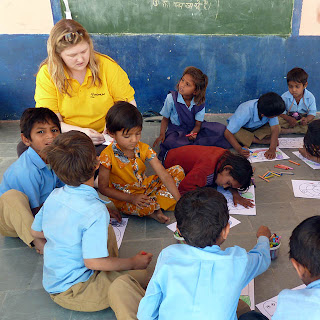We have had 2 days of public holidays here in India during
the 4th Week of Book Bus, this is for the Holi festival, also known
as the festival of colour. It is the time when winter ends and summer commences
and is always held at full moon in March. It also symbolises the triumph of
good over evil and is a time when social barriers are broken down as all people
come to together to celebrate, throwing coloured powder and water over each
other, reaffirming the idea of one brotherhood.
This morning was the part of the 2 day
celebration that gives Holi the name of Festival of colours. The family that
owns the Mandore Guest house,where we are staying, gave us bags of coloured dye
which we used to throw at each other, later it was dissolved in water and
thrown. It is a joyful and fun festival with all people taking part. Holi lowers
(but does not remove completely) the strictness of social norms, which includes
gaps between age, gender, status, and caste.
Together, the rich and poor, women and men, enjoy each other’s presence on this
day. No one expects polite behavior; as a result, the atmosphere is filled with
excitement, fun and joy.
“The legend from
which the tradition of playing colours started is full of colours in itself.
The story goes that the very colourful Indian god, Lord Krishna was jealous of his soul mate Radha's
fair complexion, since he himself was very dark.
On Holi eve, men and boys parade through the streets beating
large drums and dancing with sticks, they lead the people to places where
bonfires are built which then are lit to symbolise the legend of the burning of
Holika: the triumph of good over evil.
''The legend says there once lived a devil and powerful king,
Hiranyakshyap who considered himself a god and wanted everybody to worship him.
To his great ire, his son, Prahlad began to worship, Lord Vishnu. To get rid of
his son, Hiranyakshyap asked his sister, Holika to enter a blazing fire with
Prahlad in her lap, as she had a boon to enter fire unscathed. Legend has it
that Prahlad was saved for his extreme devotion for the lord while Holika paid
a price for her sinister desire. The tradition of burning Holika or the 'Holika
dahan' comes mainly from this legend."
Last night we went to watch the burning
of Holika in Mandore around midnight. All the woman placed flowers on the dry
sticks before lighting them, then the young men had to tear the bonfire apart
to save Prahlad. They place ears of wheat into the fire as offerings for the
fire god and to signify the coming of a new harvest. Some people say the
name Holi has been derived from a Sanskrit word "Holka", which means
cereal roasted on a pan over the fire.
Several groups of local men playing
drums and dancing entered into the guest house and encouraged us to dance
with them. Celebrating Holi with the family here has given us a real insight
into the festival that other tourists will not experience. How many chances in
adult life do you get to cover yourself in multi coloured water and dance and
sing?
Naughty young Krishna complained to his mother Yashoda about
this injustice of nature. To placate the child, doting mother asked Krishna to
apply colour on Radha's face and change her complexion according to his choice. Playful and mischievous Krishna
appreciated the idea and implemented it. The game of applying colours thus
gained so much popularity that it became a tradition and later it turned out to
be a full fledged festival. “
During Holi colours are played in the
morning , then people go home and clean themselves up, although some of us were
“got” with the more permanent dye, leaving some faces and hair different shades
of pink! Traditionally families go around visiting in the afternoon and
evening. Here in Mandore there is a big parade of Men playing drums,singing
and dancing which moves through the town, heading for Mandore Gardens. This is
one of the few times when people are allowed to drink so things can get quite
heated. Only men take part in the parade and woman watch from the rooftops. We
also watched the procession from the roof of the guest house. It has been amazing 2 days and we really feel we have experienced an Indian festival in true Indian style.
Kelly 26 & 27 March 2013























